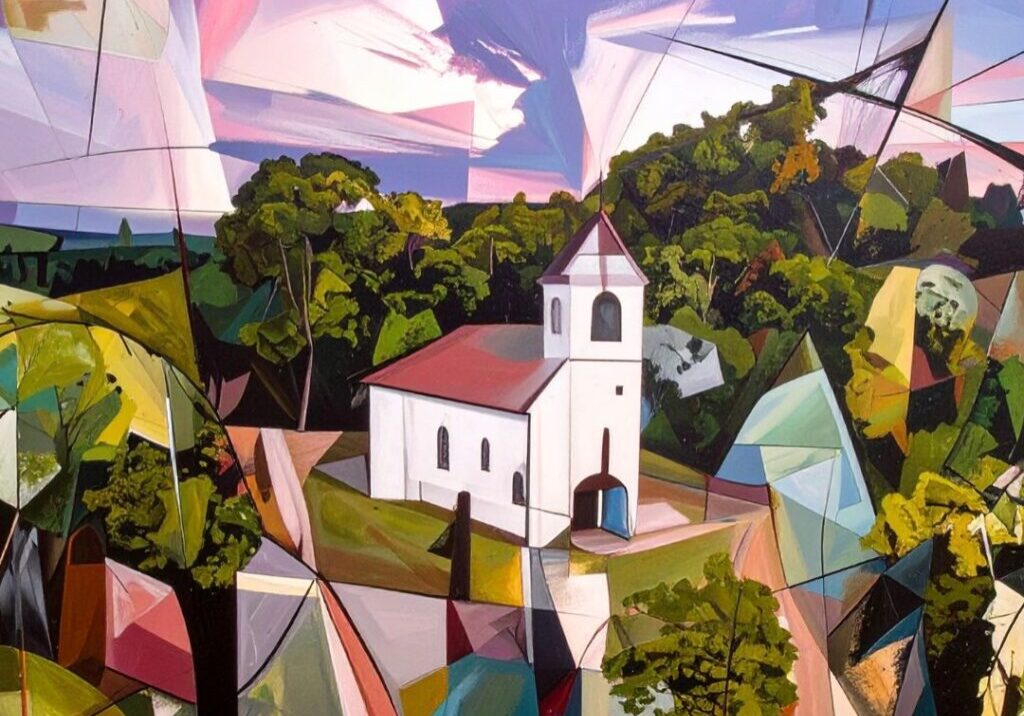The Beautiful Wholeness of Nature
Nature is an interlocking network of systems, an “unbearable wholeness of beings,” Steven Talbott wrote.[i] Nature is more flow than fixed. “The body,” he states, “is a formed”[ii] Structures, once stable formed, do not necessarily stay that way. The cell, event, for example an undividing cell such as a neuron, may experience a complete replacement of its contents a thousand times or more over the course of its life. Many of the body’s structures are more like standing waves than once-and-for all constructed objects. Organisms show a meaningful coordination of activities whereby a functioning and self-sustaining unity engages in flexible responses to the myriad stimuli of the environment. Nature is a choreographed ballet, a symphony, whereby an organism is dynamically engaged in its own self-organization, pursuing its own ends amid an ever-shifting context of relationships. Today we know that living systems are integrated wholes whose essential properties arise from the interactions and interdependence of their parts. Over billions of years of evolution many species have formed such tightly knit communities that the whole system resembles a large, multicreatured organism. Harold Bloom states that the emergence of the mind is a massively socially organized phenomenon. On every level of biological evolution, life emerges out of organized complexity.
There is a holism in nature that baffles scientists and does not let them rest easily. Recent speculation on the multiverse theory, for example, has led to a new understanding of consciousness and wholeness. Philosopher Jonathan Schaffer has mused over the question what the universe is made of According to quantum monism, that is, a singular quantum reality, the fundamental layer of reality is not made of particles or strings but the universe itself—understood not as the sum of things making it up but rather as a single, entangled quantum state. Similar thoughts were expressed, for example by the physicist and philosopher Carl Friedrich von Weizsäcker. Taking quantum mechanics seriously predicts a unique, single quantum reality underlying the multiverse. Since entanglement is universal, it doesn’t stop at the boundary of our cosmic patch. Whatever multiverse theory is postulated, when you adopt quantum monism they are all part of an integrated whole: There always is a more fundamental layer of reality underlying the many universes within the multiverse, and that layer is unique. What looks like “many worlds” from the perspective of a local observer is indeed a single, unique universe from a global perspective (such as that of someone who would be able to look from outside onto the entire universe). In other words: many worlds is how quantum monism looks like for an observer who has only limited information about the universe. Nature looks divided into separate pieces, but this is an artifact of one’s perspective.[iii]
At the beginning of the twentieth century, scientists such as David Bohm and Karl Pribam speculated on wholeness in nature and developed elaborate theories to explain wholeness as a function of consciousness. Bohm said there are two ways of seeing the universe. The first is the mechanistic order, in which the universe is seen as a collection of entities existing independently in time and space and interacting through forces that do not cause any change in the essential nature of these entities. This is the Newtonian perspective, following fundamental laws of classical physics, in which each atom, molecule, cell, organism or entity acts according to classical physical laws of motion. The second perspective, according to Bohm, is based on quantum reality which cannot be accounted for by the mechanistic order. In quantum reality, movement is generally seen as discontinuous. An electron can move from one spot to another without going through any of the space between. Particles, like electrons, can show different properties depending on the environment they are in: in some places they are particles while in other places they are waves. Finally, two particles can show “non-local relationships” which means they can be separated by vast distances but react as if they are connected to each other.[iv]
Bohm recognized that these new features of quantum theory require that the entire universe be considered as an unbroken whole, with each element in that whole demonstrating properties that depend on the overall environment. He wrote:“Thus, if all actions are in the form of discrete quanta, the interactions between the different entities (e.g. electrons) constitute a single structure of indivisible links, so that the entire universe has to be thought of as an unbroken whole.”[v] He called this unbroken wholeness “implicate order” meaning that enfolding takes place in the movements of various universal fields, including electromagnetic fields, sound waves, and others.[vi] The enfolded order is the basis of the explicit order that we perceive in the unfolded state. For example, if you take of folded paper and pierce it and then unfold the paper, the spots will appear random, separate, and unrelated. However, if the paper is folded back into its initial position, all the holes come together into the single spot that was pierced through.[vii] Bohm applied his idea of implicate order to the structure of the universe and to consciousness. He showed that what we usually think of as empty space is full of background energy. This immense background energy, Bohm states, may be the basis of implicate order and the undivided wholeness of the universe.
Bohm’s theory of implicate order is based on several important ideas. First, being is intrinsically relational and exists as unbroken wholeness in a system. Whereas classical physics is based on parts making up wholes, Bohm took relationships between parts as primary. Each part is connected with every other part at the quantum level. Thus, the whole is the basic reality. The second aspect of Bohm’s implicate order is that systems are in movement or what he calls “holomovement.” Kevin Sharpe explains: “The holomovement model for reality comes from the properties of a holographic image of an object. Any portion of the holographic plate (the hologram) contains information on the whole object.”[viii] Third, because reality is marked by relationality and movement, it has endless depth. Hence Bohm directs us to think in terms of wholes, relationality, and depth. What we know of reality does not exhaust it; properties and qualities will always be beyond us. Bohm states that a “particle” conception of matter not only causes harm to the sciences, but also to the way we think and live, and thus to our very society and its future evolution. He wrote:
The notion that all these fragments is separately existent is evidently an illusion, and this illusion cannot do other than lead to endless conflict and confusion. Indeed, the attempt to live according to the notion that the fragments are really separate is, in essence, what has led to the growing series of extremely urgent crises that is confronting us today. Thus, as is now well known, this way of life has brought about pollution, destruction of the balance of nature, over-population, world-wide economic and political disorder, and the creation of an overall environment that is neither physically nor mentally healthy for most of the people who live in it. Individually there has developed a widespread feeling of helplessness and despair, in the face of what seems to be an overwhelming mass of disparate social forces, going beyond the control and even the comprehension of the human beings who are caught up in it.[ix]
Neuroscientist Marjorie Woolacott correlates Bohm’s implicate order or unbroken wholeness with the monistic Indian philosophies. She writes: “The pan-Indian view is, simply, that pure consciousness is the substratum of everything. It is the classic statement of unity and a pure expression of the implicate order.”[x] She goes on to say that “what the Indian philosophers mean is that the one subtle order—pure consciousness– is thought to take the form of an infinite number of sub-orders” that we humans perceive and organize as the nature of reality.[xi] In this respect, consciousness is the source and power of everything. She writes: “Pure consciousness has the capacity to contract into the separate awareness of an individual—defined here as “the mind”—taking the form of the individual’s material reality.”[xii] Bohm thought that our greatest obstacle to understanding consciousness is our language—our divisive and fragmented means of thought and expression—which impels us to focus and understand the particulars to the exclusion of the whole. His implicate order and the implications of quantum theory for mind and reality provide a new paradigm for understanding the “inner” universe as part of the “outer” universe. Although his ideas have not been readily accepted in the scientific community, they are consistent with what we know from other realms of knowledge, such as we find in Indian philosophies, practitioners of yoga or meditation. There is a persistent correlation with higher levels of consciousness, the expansion of being and the unification of space.
What about self-identity? If wholeness is our deepest reality, do we have an individual “self?” Our separate self-sense is an illusion, Albert Einstein wrote, because we are part of a whole, though limited in time and space. In Ken Wilber’s words: “The ego is a contraction in the field of awareness.”[xiii] The experience of separateness is an optical illusion of one’s consciousness, which can restrict us from realizing our true reality of belonging to the whole. Einstein said, “our task is to free ourselves from this prison by widening our circle of compassion to embrace all living creatures and the whole of nature in its beauty.”[xiv]
Antonio Damasio suggests how we might free ourselves from our perception of self-separateness, to realize that viewer and viewed are one and the same flow of information: ”The images in the consciousness narrative flow like shadows along with the images of the object for which they are providing an unwitting, unsolicited comment. To come back to the metaphor of movie-in-the-brain, they are within the movie. There is no external spectator.” Or as T. S. Eliot wrote: ”The story is not told by some clever homunculus. Nor is the story really told by you as a self because the core you is only born as the story is told, within the story itself. You exist as a mental being when primordial stories are being told, and only then; as long as primordial stories are being told, and only then. You are the music while the music lasts.”
Modern science has been telling us, in so many ways, that mind and matter are part of the same cosmic stuff. The recent images of the early universe affirm what we have known for over a century, nature is an unbearable wholeness of magnificent life. Eastern religions have known this for centuries, but the dominant western world has insisted on the self-willed individual of historical change. Teilhard de Chardin saw the western mindset as the problem of modernity. “The artificial separation between humans and cosmos,” he wrote, “lies at the root of our moral confusion.” Is it possible to develop a quantum self and a quantum society in an undivided whole? Yes, it is possible because it is our deepest reality. However, all our systems must be reimagined and reorganized as interlocking wholes. Imagine what this would mean for the life of the planet! It is possible and it is within our reach, but we must have the will to change. God who is the whole of every whole will continue to empower from within, because divine love always seeks new life.
Notes:
[i] Steve Talbott, “The Unbearable Wholeness of Beings,” The New Atlantis: A Journal of Technology and Society.
[ii] Talbott, The Unbearable Wholeness of Beings,
[iii]file:///C:/Users/Ilia/Desktop/HOLISM%20BOOK/Quantum%20Monism%20Could%20Save%20the%20Soul%20of%20Physics%20-%20Scientific%20American%20Blog%20Network.htm]
[iv] David Bohm, Wholeness and Implicate Order (London: Routledge & Kegan Paul, 1980), 175.
[v] Bohm, Wholeness and Implicate Order, 175.
[vi] Bohm, Wholeness and Implicate Order, 178.
[vii] Marjorie Hines Woollacott, Infinite Awareness: The Awakening of a Scientific Mind (Lanham: Rowman & Littlefield, 2015), 76.
[viii] Sharpe, “Relating the Physics and Metaphysics of David Bohm,” http://www.ksharpe.com/Word/BM05.htm
[ix] David Bohm, Wholeness and the Implicate Order, 1980)
[x] Woollacott, Infinite Awareness, 79.
[xi] Woollacott, Infinite Awareness, 79.
[xii] Woollacott, Infinite Awareness, 85.
[xiii] Ken Wilbur, The Essential Wilbur (Boston: Shambhala, 1998), 136.
[xiv] Albert Einstein quoted in Howard W. Eves, Mathematical Circles Adieu (Washington, D.C.: The Mathematical Association of America, 2002), Page unknown.
[/et_pb_text][/et_pb_column][/et_pb_row][/et_pb_section]
 View print-friendly version
View print-friendly version
8 Comments
Related Posts

Mission for an Evolutionary Christianity
We are living through tumultuous times. Political polarization intensifies, violence against vulnerable populations escalates, and the foundational principles of human dignity face erosion. For many, the cognitive dissonance between professed…


I am always struck by the ego so embedded within all world religions. For us to even begin to perceive the Infinite we must let go of the finite. Our biases, assumptions, theories, and be awe-struck with the beauty unfolding before us. Allow ourselves time to be VERY uncomfortable with not know the whys and how’s of this beauty. Not a discomfort as we are now- with climate change, migration, extinction but uncomfortable with realizing the answer we seek may require traveling, “back to the future”.
Our Ancestors, Eastern and Western, recognized divinity and sacredness within all- eons before Medieval people decided, with their advanced consciousness, that ” this wasn’t so”.
Now, I am not saying that the ancients were “right”, medieval” wrong”, rather the concept of sacredness within has been with us for millennia. Wholeness and oneness with nature existed, and still exists (Shinto) for all to enjoy. What is lacking is openness to hearing the message. Changing behaviors. Letting go of ego. Letting go of names, titles. Therein lies the challenge.
Straining to really integrate and understand. Thank you!
To my above point, it took 29 scientists from around the globe at a cost of $10 billion to invent a telescope that expands naked eye vision millions of miles away, only to view (with greater clarity) the same spin-signed patterns in creation visible to the unassisted eye in one’s own backyard. Not naturally seen as such, there’s a living replica of the Big Bang event in every garden created by spiders in patterning their webs. Therein lies the same spinning pattern seem micro to micro, from the shape of the furthest galaxy (all galaxies), or that of the solar system, to a chrysalis, to flowers, a conch shell, beehive, etc. Earth is crammed with the archetypal patterns of heaven. Like blueprints, all things are fashioned from them. As for the spider web replicating THE act of creation, revealing (from its tiny center point) the origin of ALL acts of creation at all scales, please leave your stuffy indoor seats in classroom and laboratory to join me in a garden video link of same below. Note: The spider, like divinity in creation, not only spin-creates its web (web of life) from, by comparison, an infinitely invisible center point outwardly (an evolution), but in weaving reverses the process periphery to center (an involution), securing her web with a silky substance to catch prey, divinity harvests souls in the second half of life. Alpha and Omega are the same locale on the roundabout journey of christogenesis, and parallels the choreography from cosmogenesis to christogenesis in the interior life, spirit to matter and back again. All things return from whence they came, starting from their infinitely invisible center points (alpha), and ending there again (omega) in a circuitous ballet. Have I lost you? Then, without words, let the spider tell the sacred story of creation, creativity, and the soul’s journey in music and images only: https://youtu.be/zNtSAQHNONo
It is, after all the planet’s eleventh hour approaching Omega, and the game-clock is winding down.
I wish the great essay above could be reset within less wide margins, maybe an inch or two shorter. Then I could read it all.
You give me great hope in the teachings you offer. Grateful.
What a wonderful basis for hope this is. There is a way forward and there is a point in trying to develop our understanding and making changes to our outlook on life and then our behaviour from the perspective of the whole of it and not just the parts. Living relationally and not transactionally is very disciplined. Unfortunately it is counter cultural at present. However we all need to take up the opportunities that come our way to open ourselves up. It even broadens the very notion of what is a community doesn’t it?
I love all this wise revelation. It makes such sense to me, though I cannot pretend to understand. Perhaps that is because I am trying to understand with my cerebral self, and the more I can surrender to Spirit, the more fluidly I can join in the dance.
Having enlarged Christ to cosmic proportions, Teilhard often spoke of a “greater Christ” and a “better Christianity,” having once asked a colleague, “Can you tell me who will at last give us the meta-Christianity we are all waiting for?” Meaning, who shall step-up and connect the siloed dots every schizoid discipline currently cloisters in? We’re still waiting. Academics haven’t done it. Theologians and scientists haven’t, nor have psychologists, philosophers, and humanists. Politicians surel won’t. All these players are a loose mixture of ingredients awaiting a catalyst, the straw that stirs the drink, the player who wants the synthesis ball in his hands when the game is on the line. Now, it’s no longer the synthesis game, but the PLANET is on the line, and it’s the eleventh hour. Who shall be worthy? Divinity is always found where least expected, so look for it in that vein.